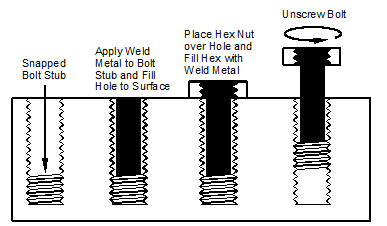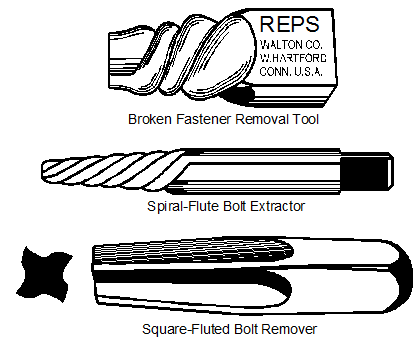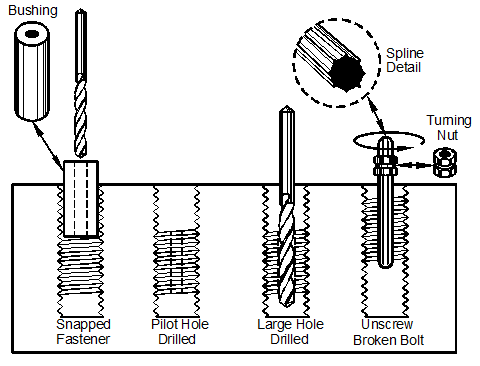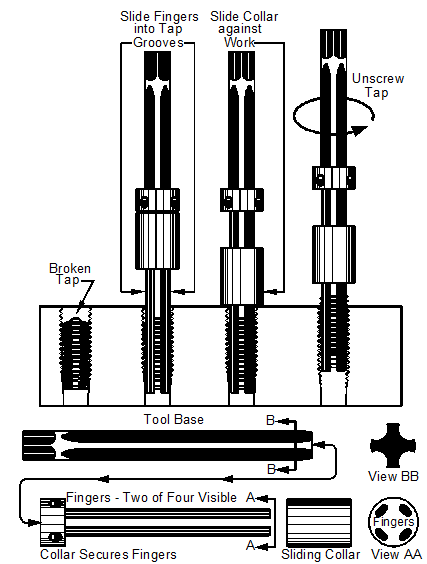What are the common methods for removing frozen or broken threaded fasteners?
Here are some approaches and cautions. Take the least destructive removal steps first. Often several steps are needed, like heat cycling, tapping and overnight penetrant. Be persistent and try alternatives. The choice of removal methods should take into consideration where the fastener was snapped—above or below the part’s surface, and what caused the failure—rust in the threads, excessive loads or over-torquing.
- Begin all fastener removal efforts by cleaning the screw or bolt head, the stem and the area around the stem where it enters the work. If the fastener has a slot or Phillips cross, clean them. Cleaning is best done with a stainless steel brush and acetone. Cleaning lets you see the problems better, gives screwdrivers a better grip on the slots, and opens a path to the threads for penetrants.
- Often a tap disintegrator (TD), also called a bolt disintegrator, metal disintegrator or spark eroder, is the best way to remove a frozen or broken fastener. This device works on the same principle as Electrical Discharge Machining (EDM) and removes the fastener quickly and without damage to the work. It works for all fastener metals. Some TDs are stationary while others may be brought to the work. When using TDs, the workpiece must be immersed in water or oil. Many machine shops have these machines and offer this service. For high-value workpieces, this is an excellent approach and presents minimum risk to the part.
- On stripped out Phillips head screws, use a die grinder (Dremel® tool) with an abrasive disc to cut a new slot. Be aware that the grinding will heat the fastener. Then use a flat-blade screwdriver in the new slot.
- On socket head cap screws whose hexes have stripped out, use a sock-it-out tool, Figure 6–34, or make one from a larger Allen wrench using a bench grinder. Hammer the sock-it-out tool into the recess. If the Allen wrench itself strips out, grind down the damaged end to expose fresh hex area.

Figure 6–34. sock-it-out tool for removing Allen-head
screws and bolts with damaged recesses.
- If the work can withstand heat, temperature cycle the fastener and surrounding areas by heating with a torch or electric heat gun. Heat small screws with a soldering iron. Do not give up until you have temperature cycled 5 to 10 times. Cool with ice or compressed air after each heating cycle. Even raising fastener/workpiece temperature 200 to 300°F may be helpful, but raising the fastener to a dull red, if the work will not be damaged, is even better. Other alternatives are heating with a butane pencil torch to limit damage to the surrounding area. If flame damage to the surrounding workpiece area is a problem, heat to red-hot the end of a piece of metal held in a Vise Grip® pliers, then apply the hot end to the top of the fastener.
- Use penetrating oil and allow it to soak in overnight. Be aware that many proprietary products, which formerly contained hydrofluoric acid and other aggressive chemicals, worked well, but have been replaced by ineffective, but government-approved hydrocarbon oils with the same names.
- Sometimes medium to light tapping on the fastener, in combination with other steps, works. Apply shock to help loosen the fastener by striking a screwdriver inserted into it or directly to the fastener itself. Do not apply so much force as to damage or snap off the fastener head. Consider tapping on the side, head or stem of the fastener with a center punch. Apply the center punch force off center, tangentially and counter clockwise to encourage the fastener to unscrew.
- Socket head cap screws are hardened and almost impossible to drill out. Consider removal by grinding them out with a diamond bit in a die grinder. After removing the bulk of the fastener, the remaining metal in the threads may be picked out with a scriber. Tap disintegrators are also excellent for removing socket head cap screws.
- Severely rusted fasteners cannot be removed by force. The three forms of iron oxide (rust) occupy a greater physical volume than the steel it came from, locking the fastener solidly in place.
- Frozen and rusted nuts can be removed by cutting them in half with a die grinder and an abrasive wheel. Nut crackers, which use a screw to drive a hardened wedge into the side of a nut while holding the other, are also effective.
- When the fastener or tap is snapped off flush or below the surface, GTAW (TIG) welding works well:
- Case I: If the fastener is flush with the work surface, a nut is placed over it and weld metal is used to join the fastener and nut. Turning the nut backs out the fastener.
- Case II: If the fastener is below the workpiece surface, weld metal is fused to the fastener, and the hole is filled with weld metal. Then a nut is added as in Case I. Skilled weldors can remove broken fasteners which are 5 to 8 diameters below the surface. Weld metal added inside the fastener hole will not adhere to the sides of the hole and ruin the threads because welding only takes place in line with the electrode, not to its sides. Tilting the GTAW torch inside the nut welds filler metal to the threads of the nut. See Figure 6–35.

Figure 6–35. Welding a nut onto a broken bolt.
- If the head is snapped off but the stem projects above the work surface, use Vise Grip® pliers to grasp the stem and unscrew it. Flats can be filed on the sides of the stem to improve your grasp.
- If the fastener has broken off flush or below the work surface and the fastener is not hardened, try a screw and bolt extractor, which come in several designs, Figure 6–36. Center punch the fastener at its center. Even better than center punching to center the drill is to use a diamond tool in a die grinder. This makes a cone-shaped depression in the top of the fastener so the drill will self-center. Except for very small fasteners, begin with a ⅛-inch diameter twist drill and drill down about ½ inch. Use drilling lubricant. A left-hand drill is better than a right-hand one because drilling forces tend to unscrew the fastener. Drill progressively larger holes until the drill hole is about half the diameter of the fastener. Reverse the drill for left-hand drills. Then, insert the largest spiral-point extractor, tap it in place so it bites into the fastener, and unscrew the fastener. Use a tap wrench to turn the extractor. Add penetrant and try to worry it out. Too much force will snap the extractor off in the drill hole and no more drilling can be done because extractor metal is hardened. Better to remove the extractor and drill the hole larger. Do the drilling in a drill press or milling machine, if possible.

Figure 6–36. Broken bolt and screw extractors.

Figure 6–37. Broken bolt removal tool using a centering
bushing and spline wrench.
- Another alternative for unhardened fasteners is a commercial product which uses a drill-centering bushing, two twist drills, spline wrench and a spline turning nut, Figure 6–37. Torque on the spline wrench is not concentrated at the point it enters the fastener hole like a screw extractor, so the wrench is less likely to snap off. The spline wrench must be tapped into the fastener hole.
Broken Tap Removal
What methods can be used to remove a broken tap from its tap hole?
- Tap removal tool, Figure 6–38, is a good choice for a first removal try. Too much force will break off fingers on the tool, so go lightly. If the tap does not come out easily, try another method.

Figure 6–38. Tap removal tool.
The removal steps are:
- Remove any loose tap material in the tap hole with tweezers or compressed air.
- Tap removal tools usually have four fingers; two can be removed for taps with just two grooves. (Three-fingered tap removers are rare.)
- Slide the fingers of the tap removal tool down into the tap grooves.
- Slide the cylindrical collar down against the workpiece to hold the fingers against the tool base.
- Back out the tap. You may need to twist the tap back and forth to worry it out rather than unscrew it in one operation.
- Nitric acid dripped into the hole dissolves the edges of the tap, reducing its diameter and easing removal. If the hole becomes too large and the threads are damaged, use a Heli-Coil. Be sure to wash the acid out completely.
- GTAW (TIG) welding works well when taps snap off flush or below the surface.
- Tap disintegrators, discussed at the start of Section V, work well on taps
